Efficient Nitrate Adsorption from Groundwater by Biochar-Supported Al-Substituted Goethite
Abstract
:1. Introduction
2. Materials and Methods
2.1. Materials
2.2. Synthesis of BC-AF
2.3. Characterizationi of BC-AF
2.4. Batch Adsorption Experiments
2.5. Reusability Potential of the Adsorbent
2.6. Analysis Method
2.6.1. Determination of NO3−-N Concentration in Solution
2.6.2. Kinetic Studies
2.6.3. Isothermal Studies
2.6.4. Thermodynamic Studies
3. Results
3.1. Characterization of BC-AF
3.2. Effect of Al/(Al + Fe) mol%
3.3. Effect of Adsorbent Dose
3.4. Effect of Solution pH
3.5. Effect of Ionic Strength
3.6. Effect of Co-Existing Anions
3.7. Adsorption Kinetic Modeling
3.8. Adsorption Equilibrium Modeling
3.9. Adsorption Thermodynamic Study
3.10. Reusability Potential of the Adsorbent
4. Discussion
4.1. Effect of Al/(Al + Fe) Molar Ratio
4.2. Effect of Operational Conditions
4.3. Kinetics, Isotherms and Thermodynamics
4.4. Adsorption Mechanism
5. Conclusions
Author Contributions
Funding
Institutional Review Board Statement
Informed Consent Statement
Data Availability Statement
Conflicts of Interest
References
- Dong, N.-Q.; Lin, H.-X. Higher yield with less nitrogen fertilizer. Nat. Plants 2020, 6, 1078–1079. [Google Scholar] [CrossRef] [PubMed]
- Yu, C.; Huang, X.; Chen, H.; Godfray, H.C.J.; Wright, J.S.; Hall, J.W.; Gong, P.; Ni, S.Q.; Qiao, S.C.; Huang, G.R.; et al. Managing nitrogen to restore water quality in China. Nature 2019, 567, 516–520. [Google Scholar] [CrossRef] [PubMed]
- Puckett, L.J.; Tesoriero, A.J.; Dubrovsky, N.M. Nitrogen Contamination of Surficial Aquifers—A Growing Legacy. Environ. Sci. Technol. 2011, 45, 839–844. [Google Scholar] [CrossRef] [PubMed]
- Martínez-Dalmau, J.; Berbel, J.; Ordóñez-Fernández, R. Nitrogen Fertilization. A Review of the Risks Associated with the Inefficiency of Its Use and Policy Responses. Sustainability 2021, 13, 5625. [Google Scholar] [CrossRef]
- Adimalla, N.; Qian, H. Groundwater chemistry, distribution and potential health risk appraisal of nitrate enriched groundwater: A case study from the semi-urban region of South India. Ecotoxicol. Environ. Saf. 2021, 207, 111277. [Google Scholar] [CrossRef]
- Picetti, R.; Deeney, M.; Pastorino, S.; Miller, M.R.; Shah, A.; Leon, D.A.; Dangour, A.D.; Green, R. Nitrate and nitrite contamination in drinking water and cancer risk: A systematic review with meta-analysis. Environ. Res. 2022, 210, 112988. [Google Scholar] [CrossRef]
- Kapoor, A.; Viraraghavan, T. Nitrate Removal from Drinking Water—Review. J. Environ. Eng. 1997, 123, 371–380. [Google Scholar] [CrossRef]
- Younker, J.; Zamlynny, L.; Spearns, C.; Rand, J. Nitrate management in a rural drinking water supply. J. Water Process Eng. 2021, 43, 102301. [Google Scholar] [CrossRef]
- Liu, Y.; Zhang, X.; Wang, J. A critical review of various adsorbents for selective removal of nitrate from water: Structure, performance and mechanism. Chemosphere 2022, 291, 132728. [Google Scholar] [CrossRef]
- Tugaoen, H.; Garcia-Segura, S.; Hristovski, K.; Westerhoff, P. Challenges in photocatalytic reduction of nitrate as a water treatment technology. Sci. Total Environ. 2017, 599–600, 1524–1551. [Google Scholar] [CrossRef]
- Zhao, F.; Xin, J.; Yuan, M.; Wang, L.; Wang, X. A critical review of existing mechanisms and strategies to enhance N2 selectivity in groundwater nitrate reduction. Water Res. 2022, 209, 117889. [Google Scholar] [CrossRef] [PubMed]
- Liu, Z.; Haddad, M.; Sauvé, S.; Barbeau, B. Alleviating the burden of ion exchange brine in water treatment: From operational strategies to brine management. Water Res. 2021, 205, 117728. [Google Scholar] [CrossRef] [PubMed]
- Gao, L.; Liu, G.; Zamyadi, A.; Wang, Q.; Li, M. Life-cycle cost analysis of a hybrid algae-based biological desalination—Low pressure reverse osmosis system. Water Res. 2021, 195, 116957. [Google Scholar] [CrossRef] [PubMed]
- Huang, J.; Chen, S.; Ma, X.; Yu, P.; Zuo, P.; Shi, B.; Wang, H.; Alvarez, P.J. Opportunistic pathogens and their health risk in four full-scale drinking water treatment and distribution systems. Ecol. Eng. 2021, 160, 106134. [Google Scholar] [CrossRef]
- Darajeh, N.; Alizadeh, H.; Leung, D.W.M.; Nodeh, H.R.; Rezania, S.; Farraji, H. Application of Modified Spent Mushroom Compost Biochar (SMCB/Fe) for Nitrate Removal from Aqueous Solution. Toxics 2021, 9, 277. [Google Scholar] [CrossRef]
- Dewage, N.B.; Liyanage, A.S.; Pittman, C.U.; Mohan, D.; Mlsna, T. Fast nitrate and fluoride adsorption and magnetic separation from water on α-Fe2O3 and Fe3O4 dispersed on Douglas fir biochar. Bioresour. Technol. 2018, 263, 258–265. [Google Scholar] [CrossRef]
- Long, L.; Xue, Y.; Hu, X.; Zhu, Y. Study on the influence of surface potential on the nitrate adsorption capacity of metal modified biochar. Environ. Sci. Pollut. Res. 2019, 26, 3065–3074. [Google Scholar] [CrossRef]
- Cheng, N.; Wang, B.; Wu, P.; Lee, X.; Xing, Y.; Chen, M.; Gao, B. Adsorption of emerging contaminants from water and wastewater by modified biochar: A review. Environ. Pollut. 2021, 273, 116448. [Google Scholar] [CrossRef]
- Spanu, D.; Binda, G.; Dossi, C.; Monticelli, D. Biochar as an alternative sustainable platform for sensing applications: A review. Microchem. J. 2020, 159, 105506. [Google Scholar] [CrossRef]
- Minh, T.D.; Song, J.; Deb, A.; Cha, L.; Srivastava, V.; Sillanpää, M. Biochar based catalysts for the abatement of emerging pollutants: A review. Chem. Eng. J. 2020, 394, 124856. [Google Scholar] [CrossRef]
- Zhang, M.; Song, G.; Gelardi, D.L.; Huang, L.; Khan, E.; Mašek, O.; Parikh, S.J.; Ok, Y.S. Evaluating biochar and its modifications for the removal of ammonium, nitrate, and phosphate in water. Water Res. 2020, 186, 116303. [Google Scholar] [CrossRef] [PubMed]
- Gai, X.; Wang, H.; Liu, J.; Zhai, L.; Liu, S.; Ren, T.; Liu, H. Effects of Feedstock and Pyrolysis Temperature on Biochar Adsorption of Ammonium and Nitrate. PLoS ONE 2014, 9, e113888. [Google Scholar] [CrossRef] [PubMed] [Green Version]
- Hollister, C.C.; Bisogni, J.J.; Lehmann, J. Ammonium, Nitrate, and Phosphate Sorption to and Solute Leaching from Biochars Prepared from Corn Stover (Zea mays L.) and Oak Wood (Quercus spp.). J. Environ. Qual. 2013, 42, 137–144. [Google Scholar] [CrossRef] [PubMed]
- Hale, S.E.; Alling, V.; Martinsen, V.; Mulder, J.; Breedveld, G.D.; Cornelissen, G. The sorption and desorption of phosphate-P, ammonium-N and nitrate-N in cacao shell and corn cob biochars. Chemosphere 2013, 91, 1612–1619. [Google Scholar] [CrossRef]
- Yao, Y.; Gao, B.; Zhang, M.; Inyang, M.; Zimmerman, A. Effect of biochar amendment on sorption and leaching of nitrate, ammonium, and phosphate in a sandy soil. Chemosphere 2012, 89, 1467–1471. [Google Scholar] [CrossRef]
- Qiu, M.; Liu, L.; Ling, Q.; Cai, Y.; Yu, S.; Wang, S.; Fu, D.; Hu, B.; Wang, X. Biochar for the removal of contaminants from soil and water: A review. Biochar 2022, 4, 19. [Google Scholar] [CrossRef]
- Liu, J.; Jiang, J.; Meng, Y.; Aihemaiti, A.; Xu, Y.; Xiang, H.; Gao, Y.; Chen, X. Preparation, environmental application and prospect of biochar-supported metal nanoparticles: A review. J. Hazard. Mater. 2020, 388, 122026. [Google Scholar] [CrossRef]
- Zhu, Z.; Huang, C.; Zhu, Y.; Wei, W.; Qin, H. A hierarchical porous adsorbent of nano-α-Fe2O3/Fe3O4 on bamboo biochar (HPA-Fe/C-B) for the removal of phosphate from water. J. Water Process Eng. 2018, 25, 96–104. [Google Scholar] [CrossRef]
- Anfar, Z.; Zbair, M.; Ahsiane, H.A.; Jada, A.; El Alem, N. Microwave assisted green synthesis of Fe2O3/biochar for ultrasonic removal of nonsteroidal anti-inflammatory pharmaceuticals. RSC Adv. 2020, 10, 11371–11380. [Google Scholar] [CrossRef] [Green Version]
- Bakshi, S.; Laird, D.A.; Smith, R.G.; Brown, R.C. Capture and Release of Orthophosphate by Fe-Modified Biochars: Mechanisms and Environmental Applications. ACS Sustain. Chem. Eng. 2021, 9, 658–668. [Google Scholar] [CrossRef]
- Cornell, R.; Schwertmann, U. The Iron Oxides: Structure, Properties, Reactions, Occurrences, And Uses; Wiley: Weinheim, Germany, 2003. [Google Scholar]
- Abdelrhman, F.; Gao, J.; Ali, U.; Wan, N.; Sharaf, A.; Hu, H. Assessment of goethite modified biochar on the immobilization of cadmium and arsenic and uptake by Chinese cabbage in paddy soil. Arch. Agron. Soil Sci. 2022, 1–16. [Google Scholar] [CrossRef]
- Irshad, M.K.; Ibrahim, M.; Noman, A.; Shang, J.; Mahmood, A.; Mubashir, M.; Khoo, K.S.; Ng, H.S.; Show, P.L. Elucidating the impact of goethite-modified biochar on arsenic mobility, bioaccumulation in paddy rice (Oryza sativa L.) along with soil enzyme activities. Process Saf. Environ. Prot. 2022, 160, 958–967. [Google Scholar] [CrossRef]
- Zhu, S.; Qu, T.; Irshad, M.K.; Shang, J. Simultaneous removal of Cd(II) and As(III) from co-contaminated aqueous solution by α-FeOOH modified biochar. Biochar 2020, 2, 81–92. [Google Scholar] [CrossRef] [Green Version]
- Zhu, S.; Zhao, J.; Zhao, N.; Yang, X.; Chen, C.; Shang, J. Goethite modified biochar as a multifunctional amendment for cationic Cd(II), anionic As(III), roxarsone, and phosphorus in soil and water. J. Clean. Prod. 2020, 247, 119579. [Google Scholar] [CrossRef]
- Schneider, F.; Haderlein, S.B. Potential effects of biochar on the availability of phosphorus—Mechanistic insights. Geoderma 2016, 277, 83–90. [Google Scholar] [CrossRef]
- Kamran, M.A.; Bibi, S.; Chen, B.; Jiang, J.; Xu, R.-K. Elucidating the mechanisms determining the availability of phosphate by application of biochars from different parent materials. Environ. Geochem. Health 2022, 1–10. [Google Scholar] [CrossRef]
- Zhang, Z.; Yu, H.; Zhu, R.; Zhang, X.; Yan, L. Phosphate adsorption performance and mechanisms by nanoporous biochar–iron oxides from aqueous solutions. Environ. Sci. Pollut. Res. 2020, 27, 28132–28145. [Google Scholar] [CrossRef]
- Zhang, X.; Gang, D.D.; Sun, P.; Lian, Q.; Yao, H. Goethite dispersed corn straw-derived biochar for phosphate recovery from synthetic urine and its potential as a slow-release fertilizer. Chemosphere 2021, 262, 127861. [Google Scholar] [CrossRef]
- Liu, L.; Liu, G.; Zhou, J.; Jin, R. Interaction between hexavalent chromium and biologically formed iron mineral-biochar composites: Kinetics, products and mechanisms. J. Hazard. Mater. 2021, 405, 124246. [Google Scholar] [CrossRef]
- You, H.; Zhang, Y.; Li, W.; Li, Y.; Ma, Y.; Feng, X. Removal of NO3-N in alkaline rare earth industry effluent using modified coconut shell biochar. Water Sci. Technol. 2019, 80, 784–793. [Google Scholar] [CrossRef]
- Hsi, C.-K.D.; Langmuir, D. Adsorption of uranyl onto ferric oxyhydroxides: Application of the surface complexation site-binding model. Geochim. Cosmochim. Acta 1985, 49, 1931–1941. [Google Scholar] [CrossRef]
- Guo, X.; Dong, H.; Yang, C.; Zhang, Q.; Liao, C.; Zha, F.; Gao, L. Application of goethite modified biochar for tylosin removal from aqueous solution. Colloids Surfaces A Physicochem. Eng. Asp. 2016, 502, 81–88. [Google Scholar] [CrossRef]
- Smith, D.E. Molecular Computer Simulations of the Swelling Properties and Interlayer Structure of Cesium Montmorillonite. Langmuir 1998, 14, 5959–5967. [Google Scholar] [CrossRef]
- Li, Y.; Chen, M.; Liu, C.; Song, H.; Yuan, P.; Zhang, B.; Liu, D.; Du, P. Effects of Layer-Charge Distribution of 2:1 Clay Minerals on Methane Hydrate Formation: A Molecular Dynamics Simulation Study. Langmuir 2020, 36, 3323–3335. [Google Scholar] [CrossRef] [PubMed]
- Lee, S.Y.; Choi, J.-W.; Song, K.G.; Choi, K.; Lee, Y.J.; Jung, K.-W. Adsorption and mechanistic study for phosphate removal by rice husk-derived biochar functionalized with Mg/Al-calcined layered double hydroxides via co-pyrolysis. Compos. Part B Eng. 2019, 176, 107209. [Google Scholar] [CrossRef]
- Seftel, E.M.; Ciocarlan, R.G.; Michielsen, B.; Meynen, V.; Mullens, S.; Cool, P. Insights into phosphate adsorption behavior on structurally modified ZnAl layered double hydroxides. Appl. Clay Sci. 2018, 165, 234–246. [Google Scholar] [CrossRef]
- Latta, D.E.; Bachman, J.E.; Scherer, M.M. Fe Electron Transfer and Atom Exchange in Goethite: Influence of Al-Substitution and Anion Sorption. Environ. Sci. Technol. 2012, 46, 10614–10623. [Google Scholar] [CrossRef]
- Xu, J.; Koopal, L.K.; Wang, M.; Xiong, J.; Hou, J.; Li, Y.; Tan, W. Phosphate speciation on Al-substituted goethite: ATR-FTIR/2D-COS and CD-MUSIC modeling. Environ. Sci. Nano 2019, 6, 3625–3637. [Google Scholar] [CrossRef]
- Li, W.; Wang, L.; Liu, F.; Liang, X.; Feng, X.; Tan, W.; Zheng, L.; Yin, H. Effects of Al3+ doping on the structure and properties of goethite and its adsorption behavior towards phosphate. J. Environ. Sci. 2016, 45, 18–27. [Google Scholar] [CrossRef]
- Belelli, P.G.; Fuente, S.A.; Castellani, N.J. Phosphate adsorption on goethite and Al-rich goethite. Comput. Mater. Sci. 2014, 85, 59–66. [Google Scholar] [CrossRef]
- Wang, H.; Cao, S.; Kang, F.; Chen, R.; Liu, H.; Wei, Y. Effects of Al substitution on the microstructure and adsorption performance of α-FeOOH. J. Alloy. Compd. 2014, 606, 117–123. [Google Scholar] [CrossRef]
- Souza, T.G.; Freitas, E.T.; Mohallem, N.D.; Ciminelli, V.S. Defects induced by Al substitution enhance As(V) adsorption on ferrihydrites. J. Hazard. Mater. 2021, 420, 126544. [Google Scholar] [CrossRef] [PubMed]
- Bahashi, J.; Bi, E. Effects of Al substitution on sorption of diclofenac to Fe(III) (hydr)oxides: Roles of phase transition and sorption mechanisms. Environ. Sci. Pollut. Res. 2022, 29, 21314–21327. [Google Scholar] [CrossRef] [PubMed]
- Ni, C.; Liu, S.; Wang, H.; Liu, H.; Chen, R. Studies on Adsorption Characteristics of Al-Free and Al-Substituted Goethite for Heavy Metal Ion Cr(VI). Water Air Soil Pollut. 2017, 228, 40. [Google Scholar] [CrossRef]
- Hsu, L.-C.; Tzou, Y.-M.; Ho, M.-S.; Sivakumar, C.; Cho, Y.-L.; Li, W.-H.; Chiang, P.-N.; Teah, H.Y.; Liu, Y.-T. Preferential phosphate sorption and Al substitution on goethite. Environ. Sci. Nano 2020, 7, 3497–3508. [Google Scholar] [CrossRef]
- Tufo, A.E.; Afonso, M.D.S.; Sileo, E.E. Arsenic adsorption onto aluminium-substituted goethite. Environ. Chem. 2016, 13, 838. [Google Scholar] [CrossRef]
- Zhu, S.; Zhang, P.; Liang, Y.; Wang, M.; Xiong, J.; Tan, W. Effects of aluminum substitution on the surface charge of colloidal goethite particles: Experiments and MUSIC modeling. Environ. Sci. Pollut. Res. 2020, 27, 38397–38406. [Google Scholar] [CrossRef]
- Wei, A.; Ma, J.; Chen, J.; Zhang, Y.; Song, J.; Yu, X. Enhanced nitrate removal and high selectivity towards dinitrogen for groundwater remediation using biochar-supported nano zero-valent iron. Chem. Eng. J. 2018, 353, 595–605. [Google Scholar] [CrossRef]
- Paterson, E.J.C.M. Iron Oxides in the Laboratory. Prep. Charact. 2000, 27, 393. [Google Scholar]
- Wawrzkiewicz, M.; Polska-Adach, E.; Wiśniewska, M.; Fijałkowska, G.; Goncharuk, O. Adsorptive removal of C.I. Direct Yellow 142 from textile baths using nanosized silica-titanium oxide. Eur. Phys. J. Plus 2019, 134, 108. [Google Scholar] [CrossRef]
- Maamoun, I.; Eljamal, O.; Eljamal, R.; Falyouna, O.; Sugihara, Y. Promoting aqueous and transport characteristics of highly reactive nanoscale zero valent iron via different layered hydroxide coatings. Appl. Surf. Sci. 2020, 506, 145018. [Google Scholar] [CrossRef]
- Mehdinejadiani, B.; Amininasab, S.M.; Manhooei, L. Enhanced adsorption of nitrate from water by modified wheat straw: Equilibrium, kinetic and thermodynamic studies. Water Sci. Technol. 2019, 79, 302–313. [Google Scholar] [CrossRef] [PubMed]
- Song, W.; Gao, B.; Xu, X.; Wang, F.; Xue, N.; Sun, S.; Song, W.; Jia, R. Adsorption of nitrate from aqueous solution by magnetic amine-crosslinked biopolymer based corn stalk and its chemical regeneration property. J. Hazard. Mater. 2016, 304, 280–290. [Google Scholar] [CrossRef] [PubMed]
- Lagergren, S.J. About the theory of so-called adsorption of solution substances. K. Sven. Vetensk. Handl. 1898, 24, 1–39. [Google Scholar]
- Ho, Y.S.; McKay, G. Pseudo-second order model for sorption processes. Process Biochem. 1999, 34, 451–465. [Google Scholar] [CrossRef]
- Maamoun, I.; Bensaida, K.; Eljamal, R.; Falyouna, O.; Tanaka, K.; Tosco, T.; Sugihara, Y.; Eljamal, O. Rapid and efficient chromium (VI) removal from aqueous solutions using nickel hydroxide nanoplates (nNiHs). J. Mol. Liq. 2022, 358, 119216. [Google Scholar] [CrossRef]
- Liu, H.; Chen, T.; Zou, X.; Qing, C.; Frost, R.L. Effect of Al content on the structure of Al-substituted goethite: A micro-Raman spectroscopic study. J. Raman Spectrosc. 2013, 44, 1609–1614. [Google Scholar] [CrossRef] [Green Version]
- Lewis, D.G.; Schwertmann, U.J.C. The Influence of Aluminum on the Formation of Iron Oxides. IV. The Influence of [Al], [OH], and Temperature. Clays Clay Miner. 1979, 27, 195–200. [Google Scholar] [CrossRef]
- Bowles, J.F.W. The Iron Oxides: Structure, Properties Reactions Occurrence and Uses. Mineral. Mag. 1997, 61, 740–741. [Google Scholar] [CrossRef]
- Shannon, R.D.; Prewitt, C.T. Effective ionic radii in oxides and fluorides. Acta Crystallogr. Sect. B Struct. Crystallogr. Cryst. Chem. 1969, 25, 925–946. [Google Scholar] [CrossRef]
- Biesinger, M.C.; Payne, B.P.; Grosvenor, A.P.; Lau, L.W.M.; Gerson, A.R.; Smart, R.S.C. Resolving surface chemical states in XPS analysis of first row transition metals, oxides and hydroxides: Cr, Mn, Fe, Co and Ni. Appl. Surf. Sci. 2011, 257, 2717–2730. [Google Scholar] [CrossRef]
- Rakovan, J.; Becker, U.; Hochella, M.F. Aspects of goethite surface microtopography, structure, chemistry, and reactivity. Am. Miner. 1999, 84, 884–894. [Google Scholar] [CrossRef]
- Gemici, B.T.; Ozel, H.U.; Ozel, H.B. Removal of methylene blue onto forest wastes: Adsorption isotherms, kinetics and thermodynamic analysis. Environ. Technol. Innov. 2021, 22, 101501. [Google Scholar] [CrossRef]
- Lin, J.; Zhan, Y. Adsorption of humic acid from aqueous solution onto unmodified and surfactant-modified chitosan/zeolite composites. Chem. Eng. J. 2012, 200–202, 202–213. [Google Scholar] [CrossRef]
- Pholosi, A.; Naidoo, E.B.; Ofomaja, A.E. Intraparticle diffusion of Cr(VI) through biomass and magnetite coated biomass: A comparative kinetic and diffusion study. S. Afr. J. Chem. Eng. 2020, 32, 39–55. [Google Scholar] [CrossRef]
- Kalantary, R.R.; Dehghanifard, E.; Mohseni-Bandpi, A.; Rezaei, L.; Esrafili, A.; Kakavandi, B.; Azari, A. Nitrate adsorption by synthetic activated carbon magnetic nanoparticles: Kinetics, isotherms and thermodynamic studies. DESALINATION Water Treat. 2015, 57, 16445–16455. [Google Scholar] [CrossRef]
- You, H.; Lin, H.; Li, Y.; Yang, Y.; Ma, Y.; Shang, Z.; Niu, X. Iron-aluminum and aluminum-single impregnated biochar composite for nitrate adsorption in rare earth wastewater: Behavior and mechanism. Biomass-Convers. Biorefinery 2022, 1–12. [Google Scholar] [CrossRef]
- Bhatnagar, A.; Kumar, E.; Sillanpää, M. Nitrate removal from water by nano-alumina: Characterization and sorption studies. Chem. Eng. J. 2010, 163, 317–323. [Google Scholar] [CrossRef]
- Zare, L.; Ghasemi-Fasaei, R. Investigation of Equilibrium Isotherm and Kinetic Modeling to Asses Sorption Characteristics of Nitrate onto Palm Leaf Biochar. Iran J. Chem. Chem. Eng. 2019, 38, 143–153. [Google Scholar]
- Herath, A.; Reid, C.; Perez, F.; Pittman, C.U.; Mlsna, T.E. Biochar-supported polyaniline hybrid for aqueous chromium and nitrate adsorption. J. Environ. Manag. 2021, 296, 113186. [Google Scholar] [CrossRef]
- Antelo, J.; Avena, M.; Fiol, S.; López, R.; Arce, F. Effects of pH and ionic strength on the adsorption of phosphate and arsenate at the goethite–water interface. J. Colloid Interface Sci. 2005, 285, 476–486. [Google Scholar] [CrossRef] [PubMed]
- Exerowa, D. Effect of adsorption, ionic strength and pH on the potential of the diffuse electric layer. Kolloid-Z. Z. Polym. 1969, 232, 703–710. [Google Scholar] [CrossRef]
- Naidu, R.; Bolan, N.; Kookana, R.S.; Tiller, K. Ionic-strength and pH effects on the sorption of cadmium and the surface charge of soils. Eur. J. Soil Sci. 1994, 45, 419–429. [Google Scholar] [CrossRef]
- Ilay, R. Short-lived Effects of Olive Pomace Biochar Produced at Different Temperatures on Nitrate (NO3−), Bromide (Br−), Sulfate (SO42−) and Phosphate (PO43−) Leaching from Sandy Loam Soils. Commun. Soil Sci. Plant Anal. 2020, 51, 2223–2243. [Google Scholar] [CrossRef]
- Mazarji, M.; Aminzadeh, B.; Baghdadi, M.; Bhatnagar, A. Removal of nitrate from aqueous solution using modified granular activated carbon. J. Mol. Liq. 2017, 233, 139–148. [Google Scholar] [CrossRef] [Green Version]
- Tong, X.; Yang, Z.; Xu, P.; Li, Y.; Niu, X. Nitrate adsorption from aqueous solutions by calcined ternary Mg-Al-Fe hydrotalcite. Water Sci. Technol. 2017, 75, 2194–2203. [Google Scholar] [CrossRef]
- Wang, Y.; Song, X.; Xu, Z.; Cao, X.; Song, J.; Huang, W.; Ge, X.; Wang, H. Adsorption of Nitrate and Ammonium from Water Simultaneously Using Composite Adsorbents Constructed with Functionalized Biochar and Modified Zeolite. Water Air Soil Pollut. 2021, 232, 198. [Google Scholar] [CrossRef]
- Vijayaraghavan, K.; Balasubramanian, R. Application of pinewood waste-derived biochar for the removal of nitrate and phosphate from single and binary solutions. Chemosphere 2021, 278, 130361. [Google Scholar] [CrossRef]


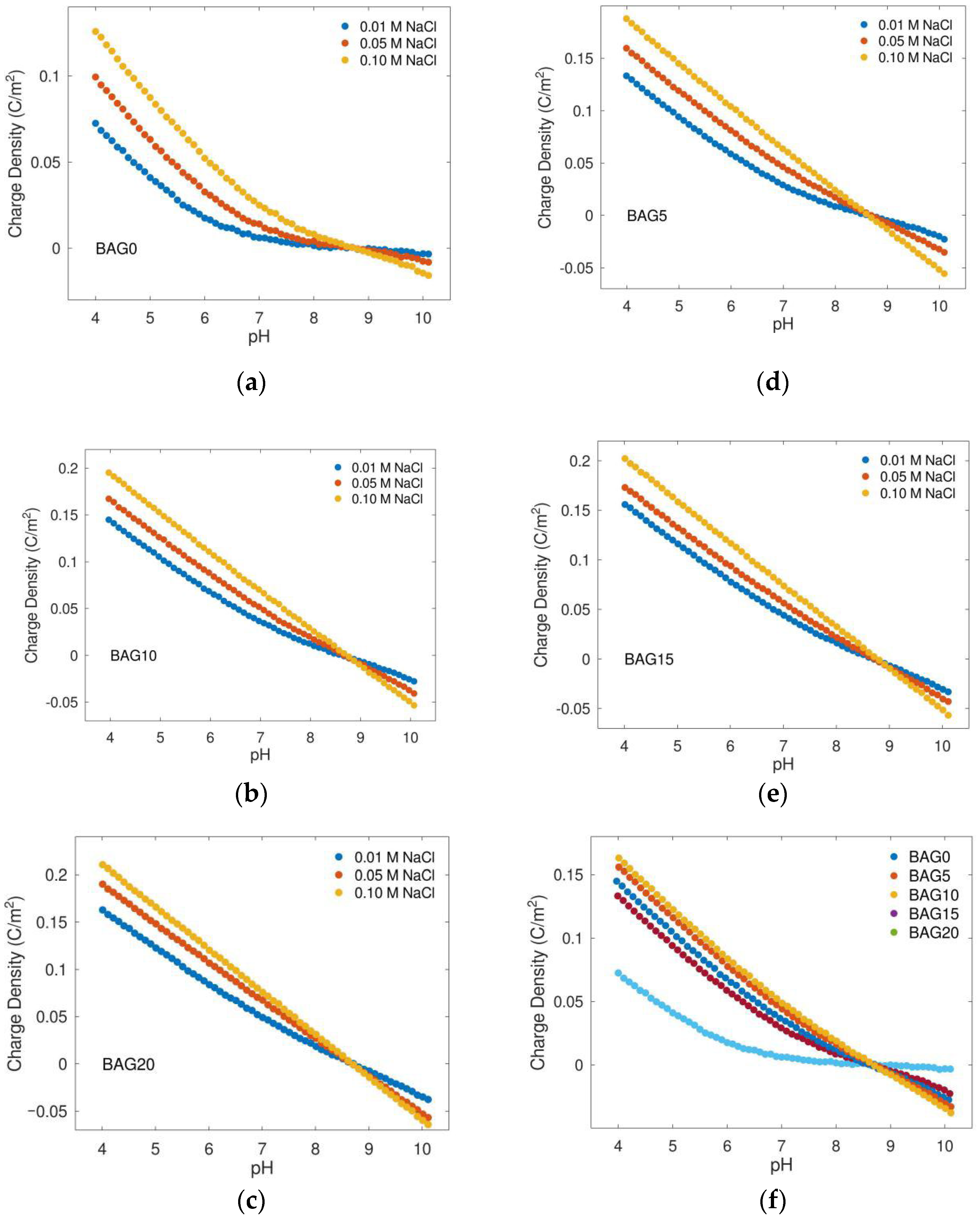

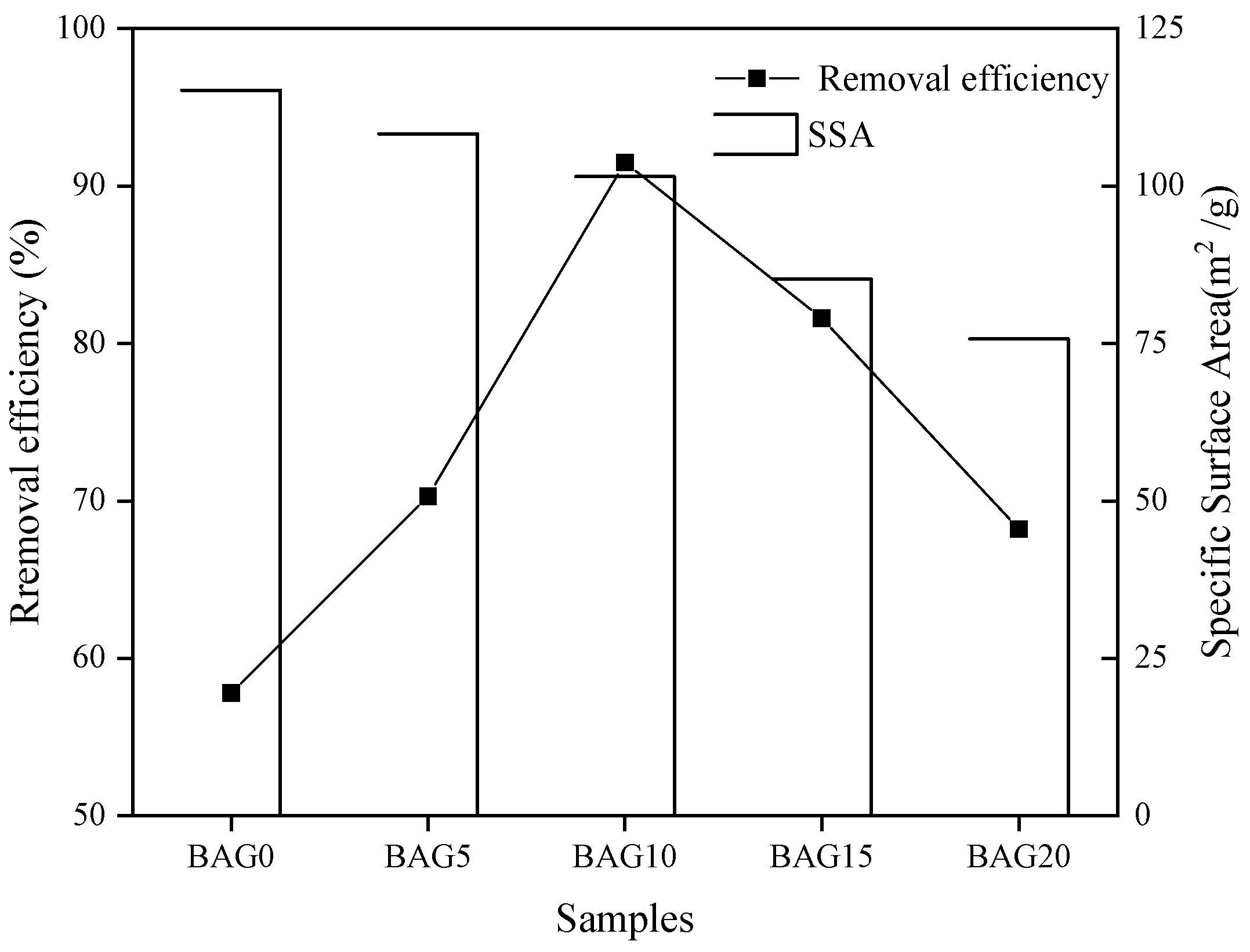
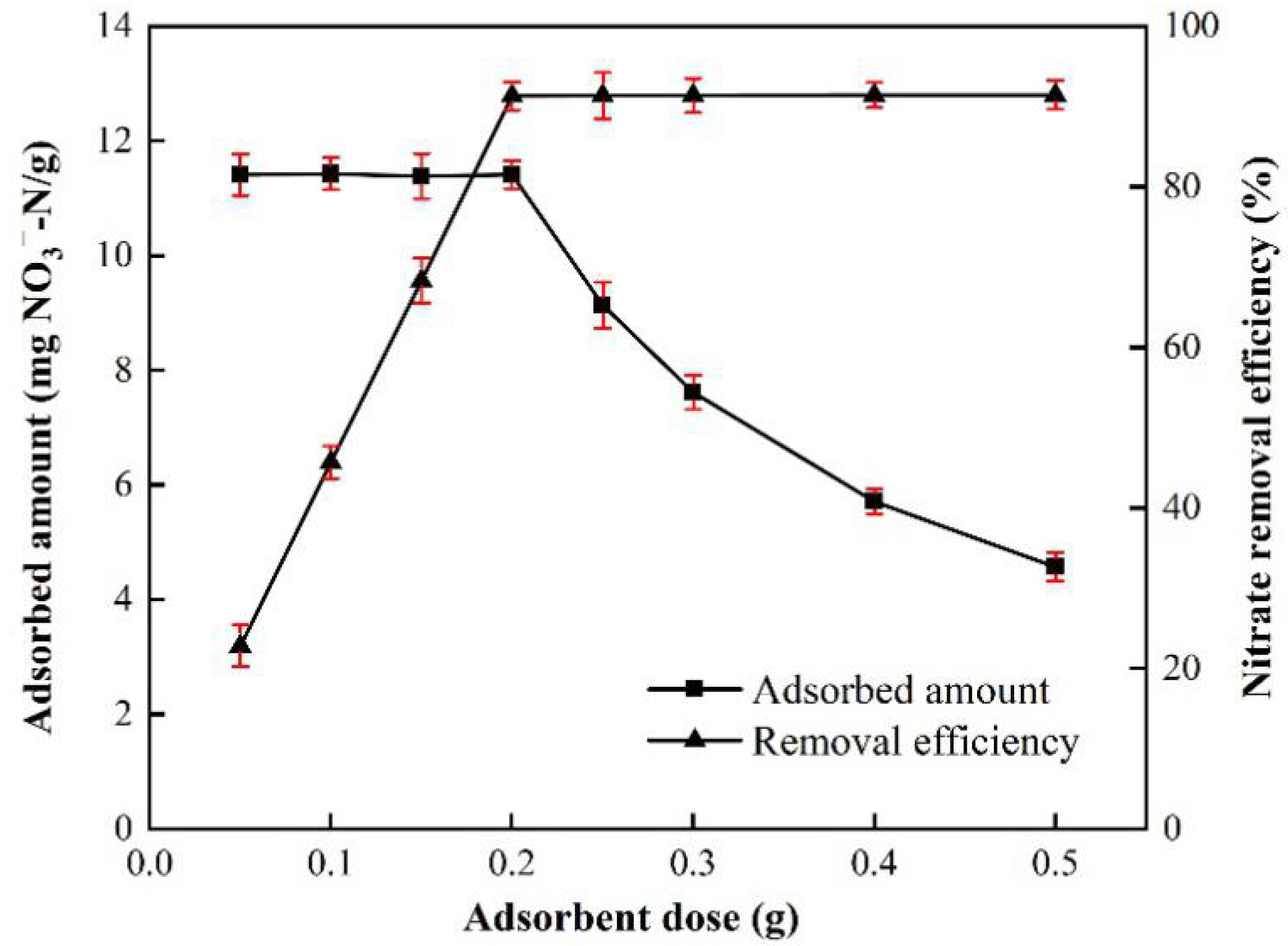

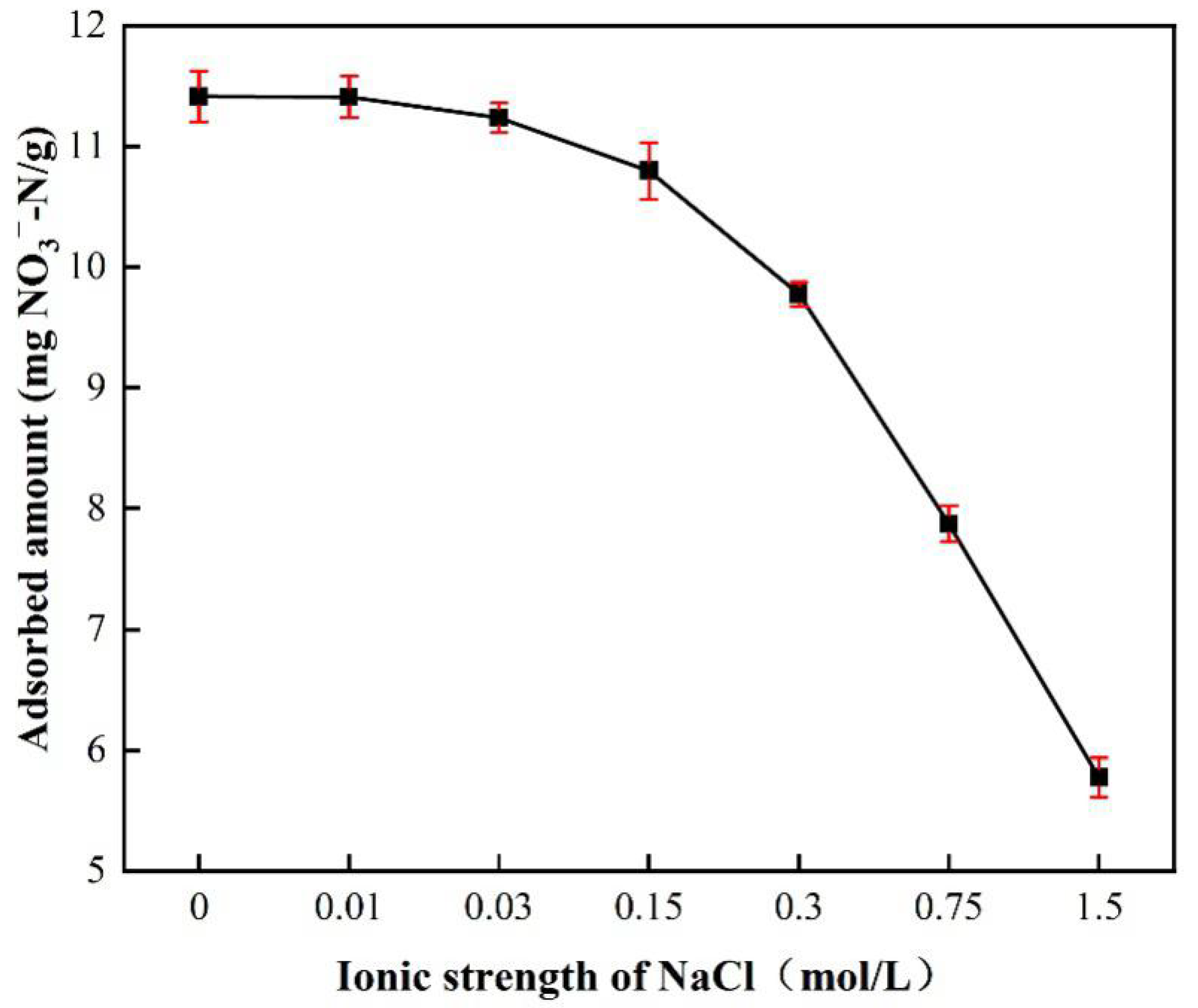

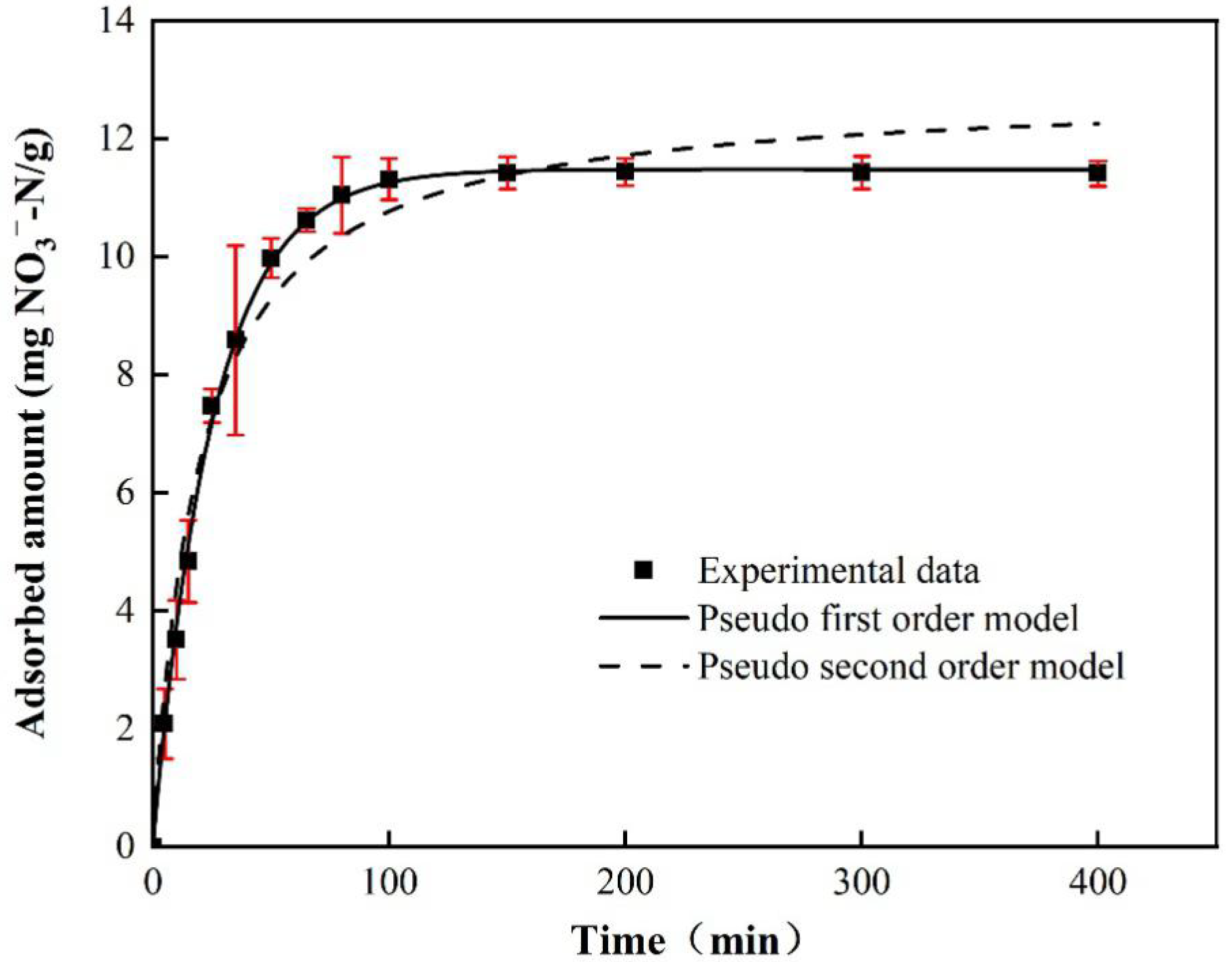
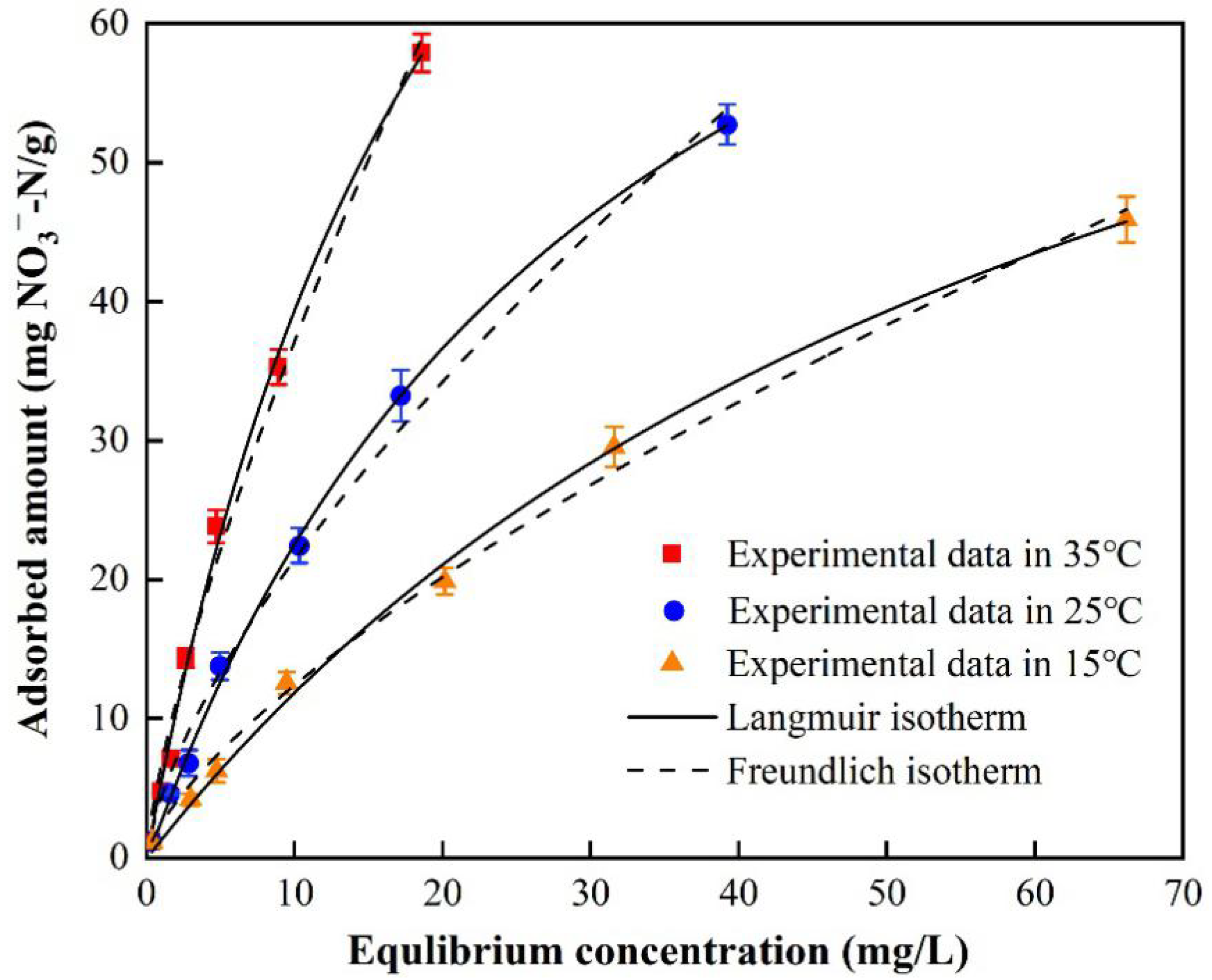
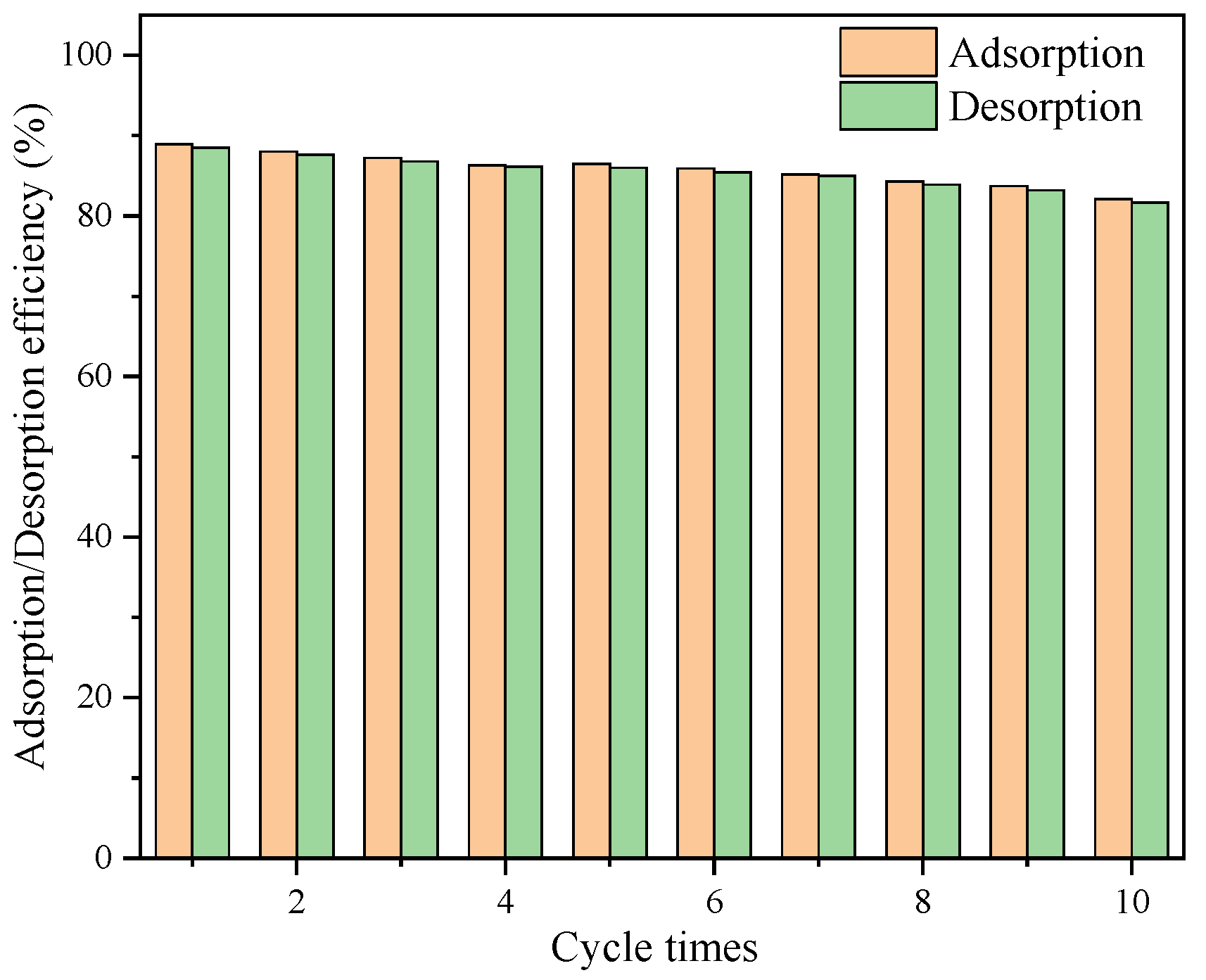

| Water Type | Monitoring Index | Maximum Value | Minimum Value | Average Value | Experimental Value |
|---|---|---|---|---|---|
| Ground water | pH | 8.01 | 6.83 | 7.45 | 7 |
| K+ | 9.18 | 0.87 | 2.90 | 0 | |
| Na+ | 953.74 | 12.98 | 286.12 | 250 | |
| Ca2+ | 140.98 | 13.05 | 43.66 | 40 | |
| Mg2+ | 274.62 | 14.56 | 61.93 | 60 | |
| Cl− | 358.32 | 15.07 | 68.87 | 60 | |
| SO42− | 604.65 | 12.26 | 42.30 | 40 | |
| HCO3− | 388.64 | 28.81 | 78.05 | 70 | |
| NO3−-N | 141.49 | 0.81 | 52.96 | 50 |
| Samples | Al Substitution Amount (mol%) | D-Spacings (Å) | Unit Cell Parameters (Å) | PZC | SSA (m2/g) | ||||
|---|---|---|---|---|---|---|---|---|---|
| (111) | (110) | (021) | a | b | c | ||||
| BAG0 | 0.00 | 2.450 | 4.186 | 2.583 | 4.614 | 9.956 | 3.022 | 8.70 | 115.2 |
| BAG5 | 2.37 | 2.448 | 4.180 | 2.581 | 4.607 | 9.941 | 3.020 | 8.59 | 108.3 |
| BAG10 | 7.95 | 2.447 | 4.176 | 2.579 | 4.604 | 9.915 | 3.020 | 8.57 | 101.5 |
| BAG15 | 12.07 | 2.446 | 4.172 | 2.578 | 4.600 | 9.905 | 3.019 | 8.61 | 85.2 |
| BAG20 | 18.26 | 2.444 | 4.168 | 2.577 | 4.594 | 9.910 | 3.017 | 8.71 | 75.7 |
| Sample | Adsorbate | qe, exp /(mg/g) | Pseudo-First-Order | Pseudo-Second-Order | ||||||
|---|---|---|---|---|---|---|---|---|---|---|
| k1/(1/min) | qe, cal /(mg/g) | R2 | AICc | k2/(1/min) | qe, cal /(mg/g) | R2 | AICc | |||
| BAG10 | NO3−-N | 11.4350 | 3.94 × 10−2 | 11.4829 | 0.9989 | 77.1 | 4.32 × 10−3 | 12.8486 | 0.9748 | 79.0 |
| Sample | Adsorbate | Temperature/ °C | Langmuir | Freundlich | ||||||
|---|---|---|---|---|---|---|---|---|---|---|
| kL/(L/mg) | qm/(mg/g) | R2 | AICc | kF | n | R2 | AICc | |||
| 15 | 1.4823 × 10−2 | 92.5870 | 0.9975 | 0.00 | 2.5050 | 1.4331 | 0.9958 | 4.05 | ||
| BAG10 | NO3−-N | 25 | 3.0932 × 10−2 | 96.1469 | 0.9986 | 26.4 | 4.6126 | 1.4922 | 0.9928 | 39.6 |
| 35 | 4.5205 × 10−2 | 126.332 | 0.9967 | 0.00 | 6.6885 | 1.3431 | 0.9900 | 9.49 | ||
| Temperature/K | lnk | ΔG/(kJ/mol) | ΔS/(J/(mol·K)) | ΔH/(kJ/mol) |
|---|---|---|---|---|
| 288 | −0.2621 | 0.6277 | 187.65 | 54.74 |
| 298 | 0.4099 | −1.016 | ||
| 308 | 1.2246 | −3.136 |
Publisher’s Note: MDPI stays neutral with regard to jurisdictional claims in published maps and institutional affiliations. |
© 2022 by the authors. Licensee MDPI, Basel, Switzerland. This article is an open access article distributed under the terms and conditions of the Creative Commons Attribution (CC BY) license (https://creativecommons.org/licenses/by/4.0/).
Share and Cite
Wang, L.; Liu, S.; Xuan, W.; Li, S.; Wei, A. Efficient Nitrate Adsorption from Groundwater by Biochar-Supported Al-Substituted Goethite. Sustainability 2022, 14, 7824. https://doi.org/10.3390/su14137824
Wang L, Liu S, Xuan W, Li S, Wei A. Efficient Nitrate Adsorption from Groundwater by Biochar-Supported Al-Substituted Goethite. Sustainability. 2022; 14(13):7824. https://doi.org/10.3390/su14137824
Chicago/Turabian StyleWang, Li, Siyuan Liu, Wendi Xuan, Shaopeng Li, and Anlei Wei. 2022. "Efficient Nitrate Adsorption from Groundwater by Biochar-Supported Al-Substituted Goethite" Sustainability 14, no. 13: 7824. https://doi.org/10.3390/su14137824






